Today the SHP is posted from Berlin , Germany
At first light on a clear Sunday morning, three Brambles semi's moved out, under escort, from the McDonalds restaurant. A few surprised motorists gave way to a partially disassembled DC-3 that filled the full width of the sidestreet. The bulky fuselage and wing centre section crouched on folded undercarriage, supported by a heavy steel I- beam secured crossways on the trailer. The pair of outer mainplanes extended the full length of another trailer, stacked root to tip. Two props, a tailfin , a rudder, and a two stage staircase, occupied the third trailer.

VH-ANW being loaded onto the trucks
The small convoy took a roundabout route, taking twenty minutes to reach the old WW11
airstrip at Caversham. Once known as Middle Swan, the
airstrip is still signposted as RAAF property. RAAF Caversham has a triangle of three landing strips that are no longer operational, but the base still serves as a radio communications station, linked to RAAF Base Pearce, further to the north at Bullsbrook. The towering mobile crane was already set up waiting, and at $150 per hour, crane time is not wasted.
Charlie Walker, the
airstrip's caretaker, had determined that the old Dak' should be positioned opposite his residence, so that he and his security dog could watch over her. The big Dog was voicing concern at all the activity, but, thankfully, Charlie had her secured
well enough away. As the clipped aircraft was lowered to the red gravel runway, cameras clicked and comment was made that it must be decades since any aircraft had touched down at Caversham. The Douglas must have felt more at
home here , than at its previous nesting place, perched up on pylons alongside a McDonalds restaurant.

VH-ANW Seen here at Parafield in her South Australian Airlines livery getting a make over.
For years this DC3 had played a sort of "cubby house" role to thousands of kids doing the McDonalds party thing. Apart from occasional use as a meeting room for various groups, the old Dak' also provided unique surroundings in which to enjoy a Big Mac. I'm certain that many diners were attracted to the Midlands restaurant purely for the opportunity to experience a DC3 up close, either for the first time, or to relive past experiences. Whilst preparing the DC3 for disassembly , I heard some interesting comments by patrons using the path under the belly of the aircraft, to get from the
carpark to the restaurant. My favourite was: " Dad,…is this aeroplane real?" " Oh no….it's just a replica." I think the little boy's dad was not kidding…but then his dad looked to be about mid twenties, and probably of the generation that would assume that the genuine article would today only be found in a museum.
"Constructors Number" 13624 was wheeled off the Oklahoma City production line in mid 1944 as a "Skytrain" for the U.S. Army Air Force. After a short term in the Pacific, she and many others like her joined the stockpile of war surplus aircraft in Manila. This particular C-47A-25-DK was purchased by Australian National Airways, to become "Moongana" , registration VH-ANW, just before Christmas day 1945. About eight and a half years later, Moongana became "Bulolo", with South Australian based Guinea Airways (not to be confused with Guinea Air Transport, based in Lae, P.N.G.). Bulolo served with Guinea as VH-GAK for a few years, until Guinea Airways was taken under the wing of Ansett- ANA.
Reverting back to her previous rego VH-ANW, she flew with Ansett-ANA for one year , before commencing just over ten and a half years of service with Ansett's Airlines of South Australia, the new identity of Guinea Airways. Retired at age 27, with about 43,000 flying
miles logged, ANW was donated to a youth
camp near
Adelaide. On 26th January, 1972, the DC3 was flown from
Melbourne to
Gawler by Captain Peter Gibbes, the same pilot who ferried it from Manila all those years ago. Captain Gibbes has the rare distinction of having flown all Douglas types DC-1 to DC-10 inclusive. A 40 year pilot, with over 20,000 hours logged, Captain Gibbes was also the youngest captain to command a Douglas airliner. At
Gawler, ANW was dismantled, then trucked a final 26
miles to the youth
camp. Reassembled on a hillside, ANW could now rest out the next 13 years in relative peace at
Chain of Ponds.
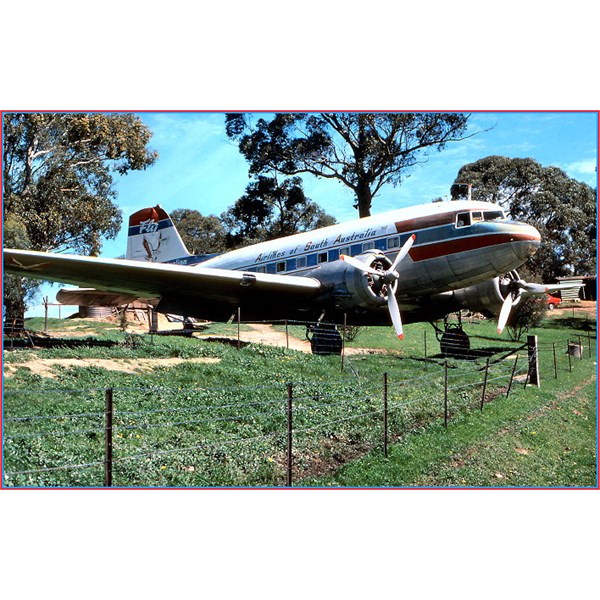
VH-ANW with Airlines of South Australia livery at Chain of Ponds 1979
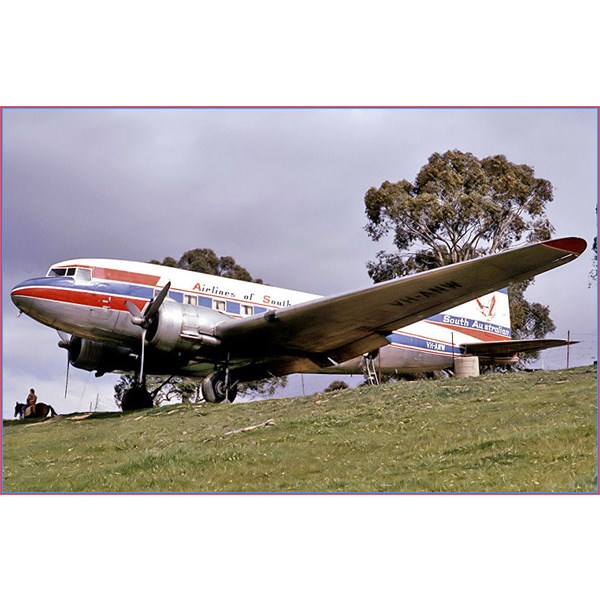
VH-ANW with Airlines of South Australia livery at Chain of Ponds
About 1985, Steve and Gail Campling , owners of the McDonalds restaurant in Midland, Western Australia, saw potential in the old airframe. The Camplings purchased ANW, had her renovated at Parafield, and then trucked the 2700 kilometers around The
Great Australian Bight to the west coast. After reassembly alongside the restaurant, and elevated to an altitude of six feet, she was officially opened for in-flight dining , in December 1987. Total cost of the exercise:
well over $140,000! During the renovation, ANW had been repainted with a new identity, that of a MacRobertson Miller Airlines DC3 which had served in Western Australia previously, VH-MMF "Fortescue". The restaurant was eventually purchased by McDonalds Australia, and the DC3 was included in the sale. Rising maintenance costs, vandalism, and the requirement for McDonalds staff to keep an eye on things "upstairs", led to the new owner's decision to close the DC3 to the public. Whilst a decision as to the fate of the aircraft was being considered, MMF became a storeroom for the restaurant.
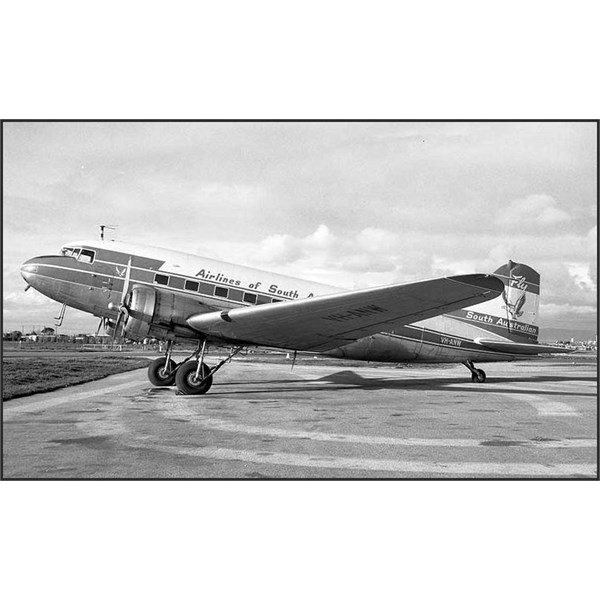
VH-ANW was one of the Guinea Airways fleet transferred to ASA
McDonalds Australia approached The Western Australian Museum of Aviation (WAMA), in November 1999, seeking assistance with the relocation of MMF to another McDonalds site, about 10 kilometers further west along Great Eastern Highway. WAMA members offered to undertake the project, for a fee to be donated to the Museum. McDonalds management then became aware that the Main Roads Department were bringing forward their plans to widen the highway at that location. This news led McDonalds to cancel their relocation plan, and instead they offered to donate the aircraft to the WAMA group, provided that WAMA pay all costs of removal. This offer was agreed to, and WAMA members began planning all the details of disassembly, transport, and eventual reassembly and display. During this time, WAMA was also looking to establish an aviation display centre closer to
Perth, whilst also retaining their small
Northam Airstrip facility. Discussions had already been in progress with Whiteman Park, about 10 kilometers Northwest of Midland. Whiteman Park is a State owned
recreation park, with a number of museum groups already established there. The museums include tractors, automobiles, a live steam train, and operational tramway system. A pioneer style village demonstrates crafts such as printing and a blacksmith's workshop.
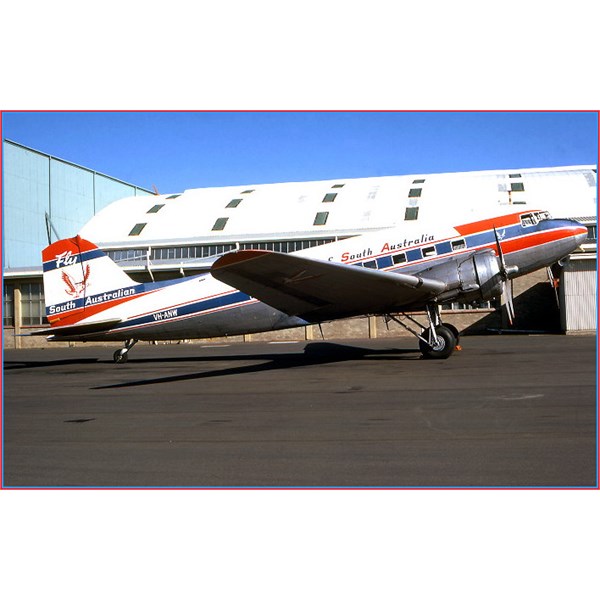
VH-ANW with Airlines of South Australia livery at Adelaide Airport 1969
At the end of February, work began on the task of preparing the aircraft for disassembly. Electrical and airconditioning connections were severed first. Then, all the underside bolts holding the mainplanes to the wing centre section were removed. The staircase was detached from the fuselage, after the interior was emptied of its stores. Both props were loosened, and numerous minor details attended to. A strict time frame had been placed upon WAMA to remove the aircraft. No cranes or trucks were allowed on site prior to 2.30 pm on the Saturday, as this was MacDonalds peak trading period of the week. The Main Roads Department had decreed that the road convoy could only proceed at first light on the following (Sunday) morning.
Construction completed at the Oklahoma City plant - June 1944 Built as a Douglas C-47A-25-DK Delivered to the
United States Army Air Force - June 16, 1944 Allocated U.S. serial number 42-93685, Delivered to Pacific Air Transport Command, Manila - June 24, 1944, Withdrawn from use and transferred to U.S. Foreign Disposals Commission - 1945 Sold to Australian National Airways - December 1945 Aircraft had flown 2,135 hours Ferried Manila-
Brisbane for conversion to civilian standards, - December 13 - 14, 1945 Ferry route: Manila-Tacoblan-Morotai-Biak-
Cooktown-
Brisbane Entered onto the Australian Aircraft Register as VH-ANW - December 13, 1945 Registered to Australian National Airways Pty Ltd Aircraft was named 'Moogana' (shake hands) Entered service with A.N.A. as a freighter - December 24, 1945 Converted to full passenger configuration with 24 seats - September 1947 Converted to Wright GR-1820-G202A cyclone engines - November / December 1948 Sold to Guinea Airways Ltd - May 28, 1954 Aircraft named 'Bulolo' Reregistered as VH-GAK - May 2, 1958 Registered to Guinea Airways Ltd Reregistered as VH-ANW - January 25, 1960 Entered service with Ansett-ANA on mainly south-eastern Australia routes - February 11, 1960 Registered to Airlines of South Australia Pty Ltd - February 14, 1961 Registered to Australian National Airways Pty Ltd - December 14, 1964 Operated final Airlines of South Australia
Adelaide-
Maralinga-
Adelaide service - December 21, 1967 Flight crew: Capt R. Weston; F/O J. Evans Reregistered to Ansett Transport Industries (Operations) Pty Ltd - November 25, 1969 Ferried
Adelaide-
Melbourne (Essendon) for storage along with VH-ABR - March 15, 1971 Reactivated for Airlines of South Australia following the destruction of Friendship VH-FNE - March 28, 1971 Returned to service - March 29, 1971 Operated the final Airlines of S.A. scheduled DC-3 service
Woomera-
Adelaide - October 4, 1971 Withdrawn from use and ferried
Adelaide-
Melbourne - October 4, 1971 Donated to Dame Nancy Butterfield, a South Australian Senator - January 26, 1972 Intended to be used at the Fairfield Venture Youth Club playground at Youth
Camp Fun Park, S.A. Ferried
Melbourne (Essendon)-RAAF
Gawler - January 27, 1972 Flight crew: Capt P. Gibbes, W. Taylor; Hostess R. Sinnett Cancelled from the Australian Aircraft Register - January 27, 1972 Aircraft had flown 43,547 hours Wings, tail, propellers removed over the next few days in preparation for road transportation to
Chain of Ponds Twelve Ansett engineers reassembled the aircraft at its new
home Provided enjoyment for many underprivilaged children at the Youth
Camp for next 13 years Acquired by Steve Campling, owner of a McDonalds Restaurant at Midland,
Perth - 1985 It was his intention to mount the aircraft outside his restuarant for use as a food hall Returned by road to Parafield Airport for refurbishment by Southern Air Maintenance - November 7, 1985 Refurbishment took 12 to 18 months to complete at a cost of some $AUD 140,000 Departed
Adelaide by road for Midland, W.A. - July 20, 1987 Aircraft was painted to represent MMA DC-3 'VH-MMF - Fortescue' Officially opened as the 'Flying Hamburger' by Dame Mary Durack Miller - December 7, 1987 Was a great success with patrons with some 2,500 people per week dining in the old aircraft From time to time Ansett W.A. executives held breakfast sales meetings inside it During the 1990s MacDonalds Australia acquired the restaurant By mid 1998 the aircraft had become a storage facility and suffered from an increase in vandalism Due to a 'duty of care' to its employees and patrons MacDonalds took steps to remove the aging aircraft Technical assistance was sought from the West Australian Museum of Aviation to dismantle aircraft Was intended to move the aircraft to the MacDonalds store at Ascot These plans were abandoned and the aircraft was donated F.O.C. to the W.A.M.A. Ownership transferred to W.A.M.A. - February 12, 2000 Transported by road to the RAAF Airfield at Caversham for storage and restoration - February 13, 2000 Used by the ABC in their TV series 'Shark Net' painted in a T.A.A. livery - November 2002 Maylands Historical Society approached the W.A.M.A. seeking to relocate the aircraft - January 2003 It was their intention to locate the aircraft at the old Maylands Aerodrome Aircraft advertised for sale by the W.A.M.A. - March 22, 2003 Following an open-inspection of the aircraft at its present site tenders for its purchase closed - May 16, 2003 Purchased by Mr Blair Howe, Myalup, Western Australia - May 16, 2003 Departed Caversham on three semi-trailers to his property at Myalup,
Busselton, W.A. - August 23, 2003 The 120km road trip took some 4 hours to complete Wings and other equipment were refitted to the aircraft over the following days Aircraft raised off the ground on metal stirrups to preserve the tyres - August 30, 2003 Mr Blair's reason for its purchase was to preserve it as he was concerned about its future if left with W.A.M.A.
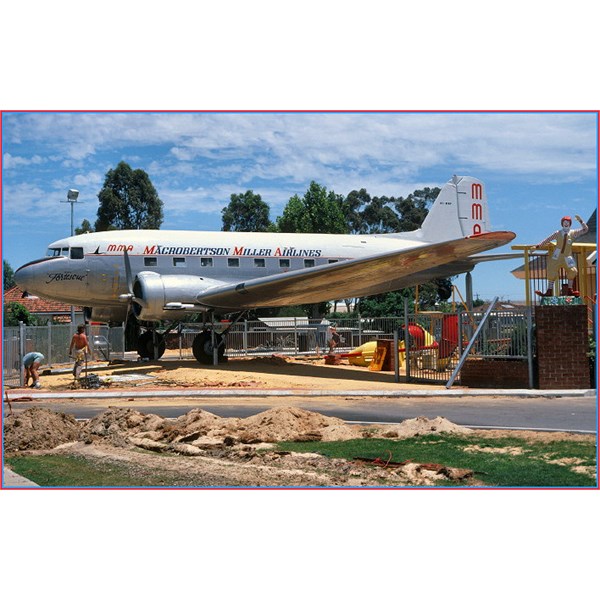
VH-ANW with MacRobertson Miller Airlines livery at Midland WA, 1987
.